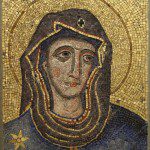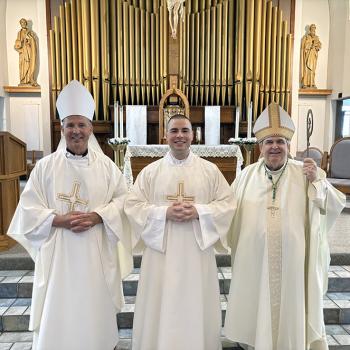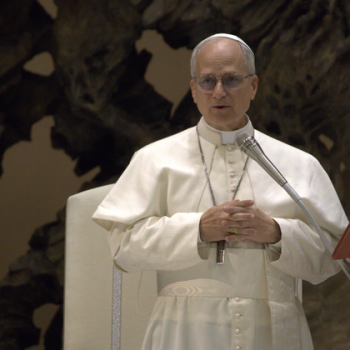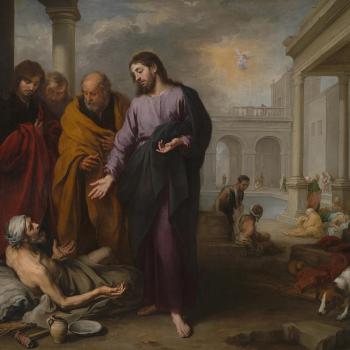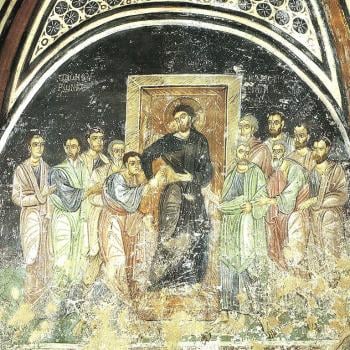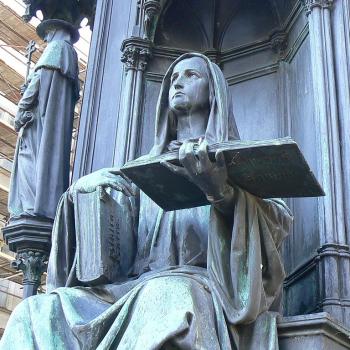![Head of Virgin Mary By Римский мастер первой половины XIII века [Public domain], via Wikimedia Commons](https://wp-media.patheos.com/blogs/sites/637/2016/04/Head_of_Virgin_Mary_from_Old_Saint_Peters_Basilica_13th_c._Pushkin_museum-2-264x300.jpg)
By Римский мастер первой половины XIII века [Public domain], via Wikimedia Commons
From what we have recorded of the writings of the earliest Christians, it is apparent that many quickly came to realize that Mary should be seen as the second or New Eve. Once Paul demonstrated that Jesus should be understood as the New and Second Adam, bringing forth a spiritually reformed humanity which is to be united with him in the way fallen humanity was united under Adam, it was soon realized that Mary was the New Eve. She had been given a role uniquely her own in human history. Her whole life was perfectly lived out in loving service to God. Her mission was united with the life and destiny of her son, Jesus, so that all through his life, she was the one constant, as she would be with him from his birth all the way to the cross.[1]
When we turn to the works of St. Justin Martyr, we can find an early example of this Marian reflection.[2] Talking about Mary in his dialogue with Trypho, he bought out the way she could be seen overturning the mistakes of Eve. God restored the original integrity of humanity by reversing the activity which led to the fall. Since Eve was the first to fall to Satan, the new Eve, the Virgin Mary, was to reverse this by her fidelity to God. After explaining how Jesus, as the Son of God, preceded creation, Justin explained that:
… He became man by the Virgin, in order that the disobedience which proceeded from the serpent might receive its destruction in the same manner in which it derived its origin. For Eve, who was a virgin and undefiled, having conceived the word of the serpent, brought forth disobedience and death. But the Virgin Mary received faith and joy, when the angel Gabriel announced the good tidings to her that the Spirit of the Lord would come upon her, and the power of the Highest would overshadow her; wherefore also the Holy Thing begotten of her is the Son of God; and she replied, ‘Be it unto me according to thy word.’ And by her He has been born, to whom we have proved so many Scriptures refer, and by whom God destroys both the serpent and those angels and men who are like him; but works deliverance from death to those who repent of their wickedness and believe upon him. [3]
St. Irenaeus, coming out of the tradition of the Apostle John, provides another example of this teaching.[4] He explained well how the work of Mary served Christ’s recapitulation of the world:
That the Lord then was manifestly coming to His own things, and was sustaining them by means of that creation which is supported by Himself, and was making a recapitulation of that disobedience which had occurred in connection with a tree, through the obedience which was [exhibited by Himself when He hung] upon a tree, [the effects] also of that deception being done away with, by which that virgin Eve, who was already espoused to a man, was unhappily misled—was happily announced, through means of the truth [spoken] by the angel to the Virgin Mary, who was [also espoused] to a man. For just as the former was led astray by the word of an angel, so that she fled from God when she had transgressed His word; so did the latter, by an angelic communication, receive the glad tidings that she should sustain (portaret) God, being obedient to His word. And if the former did disobey God, yet the latter was persuaded to be obedient to God, in order that the Virgin Mary might become the patroness (advocata) of the virgin Eve. And thus, as the human race fell into bondage to death by means of a virgin, so is it rescued by a virgin; virginal disobedience having been balanced in the opposite scale by virginal obedience. For in the same way the sin of the first created man (protoplasti) receives amendment by the correction of the First-begotten, and the coming of the serpent is conquered by the harmlessness of the dove, those bonds being unloosed by which we had been fast bound to death.[5]
Important to what St. Irenaeus explained is the way he said Mary was freely persuaded to follow God, to choose God, so as to balance out what had been done by Eve. For this to be possible, she needed to be, like Eve, in a position to choose or not to choose God, to be free from the bondage of sin while free to deny God. Her affirmation of God, at the annunciation, gave to her greater graces, strengthening and perfecting her as she then transcended the original glory of Eve and took on the glory of being the Mother of God.[6]
As Christians continued to contemplate their faith more, they would develop their understanding of what it meant to see Mary as the New Eve. Jesus’ words would be examined and reexamined, leading many to see hidden in some of them, such as in his parables, various ways Jesus was talking about the role of Mary in salvation history. For example, Jesus had a rather short parable about the kingdom of God: “And again he said, ‘To what shall I compare the kingdom of God? It is like leaven which a woman took and hid in three measures of flour, till it was all leavened’” (Lk. 13:20-21 RSV). Having internalized what it meant for Mary to be called “woman” by Christ, St. Peter Chrysologus, in his interpretation of the parable, saw it as a description of the work of Mary:
The woman took the yeast of faith from God, after she had taken the yeast of infidelity from the devil. She hid it in three measures, that is, in three periods of human history, namely from Adam to Noah, from Noah to Moses, and from Moses to Christ, in order that woman, who had corrupted the whole mass of the human race by the yeast of death in Adam, to restore the whole mass of our flesh in Christ with the yeast of the resurrection; so that the woman who had prepared the bread of sweat and tears might bake the Bread of life and salvation, and might truly be through Christ the mother of all the living, she who in Adam was the mother of all the dead.
For it was indeed for this reason that Christ willed to be born, that just as death came to all through Eve, so life might return to all through Mary.[7]
Adam and Eve, the first man and woman, represented Man and Woman, even as Adam in himself represented the whole of humanity (because Eve came from him). Through Eve, humanity was beguiled by Satan and entered the darkness of sin. From Mary, this darkness was able to be overcome, as St. Anthony of Padua preached: “The beginning of the night was when the devil, in the serpent, tempted Eve; the beginning of day was the angel’s greeting to Mary.”[8] In the creation of Adam and Eve we have God establishing in humanity a distinction of genders.[9] Jesus, the Son of Man and Son of God, recapitulates Adam, both in the universality of Adam as well as in the gender distinction established within Adam. He is the new and second father for humanity, and he gives us a spiritual rebirth so that we can be born again and overcome the consequences of the fall. Mary, his mother, is the restoration of womanhood to its integral purity, and so is the Second Eve. She is woman, the universal mother of all who are to be saved; she represents the purity of womanhood in eternity. She is the second, restored Eve, the Eve who said yes to God. Jesus is Man, just as Adam is Man, and Mary is Woman, even as Eve is Woman. To call her woman, therefore, is to point to Mary’s universal significance, to point to her as the New Eve.[10] She works with Jesus to represent the fullness of humanity. Her concerns are concerns which relate to the whole of humanity.This is why Jesus asked Mary at the Wedding of Cana, “What does this have to do with us?” It was not, what does this have to do with me, but what does this have to do with us, that is, what does this have to do with our combined mission in the world as the new Adam and Eve, the New Man and New Woman? That Jesus performed the miracle as Mary requested demonstrates that her wish was in accord with their combined mission. His question, therefore, should not be seen as if he disrespected his mother, but the reverse; it was to demonstrate her unique position in salvation history, that as the New Eve, whose life and work as one with his as the New Adam.
More to Come
[1] Certainly there were times when Jesus was not physically by her side, such as the time in which he went to the dessert to prepare for his ministry, but even in those occasions, her love and prayers with him in spirit. And yet, when his life is looked at in totality it is clear that Mary was with him from his birth to his death, never abandoning the path God set up for her, and so overturning the disobedience of Eve in the process.
[2] St. Justin was beheaded during the reign of Marcus Aurelius, and his works are among the most important representation we have of how the Christian faith was understood by an intellectual second century Christian layman. He was a philosopher who converted to the Christian faith and continued to teach it to others following the way philosophers taught. He brought a great deal of intellectual respectability to the Christian faith as he addressed non-Christian concerns, expressing philosophically many Christian teachings, as well as by the way he explained why Christians should not be persecuted by the Roman authorities but respected as loyal citizens of Rome.
[3] St. Justin Martyr, Dialogue with Trypho in ANF(1):249.
[4] St. Irenaeus of Lyons in his youth had met with and heard the Christian faith explained by St Polycarp, and St Polycarp, a very famous martyr, had himself been taught by the Apostle John. Irenaeus died a martyr’s death at the end of the second or the beginning of the third century. He was an important writer who helped keep the orthodox tradition alive when various speculations and outright heresies were confusing the faithful. His works give us a general guide as to the basic elements of the faith handed down in the pre-Nicene age. They also give us a general understanding the various “gnostic: groups which confronted the Christian faith, how and why they arose, and the responses Christians gave to them.
[5] St. Irenaeus, Against Heresies in ANF(1):547 [Book V, chapter 19].
[6] This can explain the intuition of many ancient writers as they talked about grace entering Mary at the annunciation. It was not that she was impure, for she had grace freeing her from sin since the time of her conception, but rather, she was still given a choice, a choice which then opened up to further, and greater grace, which she could have denied. Her acceptance of it allowed her to conceive God the Word in her womb and give her a glory greater than any other in creation.
[7] St. Peter Chrysologus, Selected Sermons. Volume 3. trans. William B. Palardy (Washington, DC: The Catholic University of America Press, 2005), 108.
[8] St. Anthony of Padua, Sermons for Sundays and Festivals. Volume III. trans. Paul Spilsbury (Padova: Messaggero di Sant’Antonio, 2009), 315.
[9] Such distinction should not be seen as some indication of a difference in quality or value between one gender with another, so as to pit genders against each other, thinking one is better than the other. The genders should work together, complementing each other in love. We are to help each other in and through our diversity. The gender distinction, which is not to be seen as a real ontological distinction which divides humanity (there is neither male nor female in Christ), helps demonstrate the plurality available in humanity and shows such plurality is itself a good given to us by God. Sin has divided humanity and used the distinctions to create a rupture in human nature which was not intended by God, and which will not exist in the eschaton as humanity is healed from the wound of sin thanks to the grace of Christ. We are to embrace each other in love and promote the unique qualities found in each person, qualities which include but are not limited by, the gender distinctions we find in humanity.
[10] As it is a woman who is seen in Revelation 12, as we will discuss later, we can see how this applies to Mary and indeed, reflects Mary who is the universal woman of the new creation.
Stay in touch! Like A Little Bit of Nothing on Facebook:
A Little Bit of Nothing


